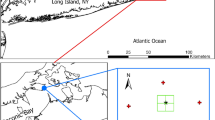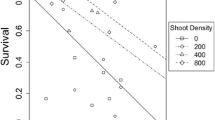Abstract
Eelgrass, Zostera marina, is generally regarded as the preferred habitat of bay scallops, but in some cases scallop populations have persisted or increased in areas lacking eelgrass. This suggests that some other substrate(s) may serve important ecological functions for bay scallops. One candidate is Codium fragile, a macroalgal species with which bay scallops are known to associate and in which we commonly find juvenile and adult bay scallops in eastern Long Island, New York. In this study, we examined whether survival of planted bay scallops differed in Codium, eelgrass, and Codium + eelgrass substrates at two sites during August and October of 2 years. Survival of tethered scallops and recoveries of live free-planted individuals varied with scallop size, planting season and year, but no differences were observed between the three substrates for a given scallop size and planting date. Crab (particularly Dyspanopeus sayi) and whelk predation were implicated as important causes of tethered scallop mortalities while emigration and removal by predators likely contributed to scallop losses. Densities of naturally recruited 0+ years scallops recovered by visual and suction dredge sampling were similar in the eelgrass and Codium substrates. While our results suggest that Codium may offer some degree of predation refuge for bay scallops, further work needs to weigh the potential disadvantages of this substrate (such as low DO levels, potential attachment and transport of scallops, and differences in current flow, food availability and sedimentation relative to eelgrass) to determine if Codium may serve as a valuable habitat for bay scallops throughout their lifespan.






Similar content being viewed by others
References
Ambrose WG Jr, Irlandi EA (1992) Height of attachment on seagrass leads to a trade-off between growth and survival in bay scallop Argopecten irradians. Mar Ecol Prog Ser 90:45–51
Arnold WS (2001) Bivalve enhancement and restorations strategies in Florida, U.S.A. Hydrobiologia 465:7–19
Arnold WS, Marelli DC, Bray CP, Harrison MH (1998) Recruitment of bay scallops Argopecten irradians in Floridan Gulf of Mexico waters: scales of coherence. Mar Ecol Prog Ser 170:143–157
Barbeau MA, Scheibling RE (1994) Procedural effects of prey tethering experiments: predation of juvenile scallops by crabs and sea stars. Mar Ecol Prog Ser 111:305–310
Belding DL (1910) A report upon the scallop fishery of Massachusetts. The Commonwealth of Massachusetts, Boston
Bishop M, Rivera J, Irlandi EA, Ambrose WG Jr, Peterson CH (2005) Spatio-temporal patterns in the mortality of bay scallop recruits in North Carolina: investigation of a life history anomaly. J Exp Mar Biol Ecol 315:127–146
Bologna PAX, Heck KL (1999) Differential predation and growth rates of bay scallops within a seagrass habitat. J Exp Mar Biol Ecol 239:299–314
Bologna P, Wilbur A, Able KW (2001) Reproduction, population structure, and recruitment failure in a bay scallop (Argopecten irradians) population from coastal New Jersey, USA. J Shellfish Res 20:89–96
Bulleri F, Abbiati M, Airoldi L (2005) The colonisation of human-made structures by the invasive alga Codium fragile spp. tomentosoides in the north Adriatic Sea (NE Mediterranean). Hydrobiologia 555:263–269
Bulleri F, Airoldi L, Branca GM, Abbiati M (2006) Positive effects of the introduced green alga, Codium fragile ssp. tomentosoides, on recruitment and survival of mussels. Mar Biol 148:1213–1220
Carlton J, Scanlon J (1985) Progression and dispersal of an introduced alga: Codium fragile ssp. tomentosoides (Chlorophyta) on the Atlantic coast of North America. Botanica Marina 28:155–165
Cashin Associates (1996) Peconic Estuary Program final submerged aquatic vegetation study. Suffolk County Department of Health Services, USA
Darcy M, Eggleston D (2005) Do habitat corridors influence animal dispersal and colonization in estuarine systems? Landscape Ecol 20:841–855
Dennison WC, Marshall GJ, Wigand C (1989) Effect of “brown tide” shading on eelgrass (Zostera Marina L.) distributions. In: Cosper EM, Bricelj VM, Carpenter EJ (eds) Novel phytoplankton blooms: causes and impacts of recurrent brown tides and other unusual blooms. Springer, Berlin, pp 675–692
Eckman JE (1987) The role of hydrodynamics in recruitment, growth, and survival of Argopecten irradians (L.) and Anomia simplex (D’Orbigny) within eelgrass meadows. J Exp Mar Biol Ecol 106:165–191
Ferner M, Smee D, Weissburg M (2009) Habitat complexity alters lethal and non-lethal olfactory interactions between predators and prey. Mar Ecol Prog Ser 374:13–22
Garcia-Esquivel Z, Bricelj VM (1993) Ontogenetic changes in microhabitat distribution of juvenile bay scallops, Argopecten irradians irradians (L.), in eelgrass beds, and their potential significance to early recruitment. Biol Bull 185:42–55
Gutsell JS (1930) Natural history of the bay scallop. US Bureau Fish Bull 46:569–632
Hamilton PV, Koch KM (1996) Orientation toward natural and artificial grassbeds by swimming bay scallops, Argopecten irradians (Lamarck, 1819). J Exp Mar Biol Ecol 199:79–88
Irlandi EA, Ambrose WG Jr, Orlando BA (1995) Landscape ecology and the marine environment: how spatial configuration of seagrass habitat influences growth and survival of the bay scallop. Oikos 72:307–313
Irlandi EA, Orlando BA, Ambrose WG Jr (1999) Influence of seagrass habitat patch size on growth and survival of juvenile bay scallops, Argopecten irradians concentricus (Say). J Exp Mar Biol Ecol 235:21–43
Kelley KM (1981) The nantucket bay scallop fishery: the resource and its management. Shellfish and Marine Department, Nantucket
Kraufvelin P, Salovius S (2004) Animal diversity in Baltic rocky shore macroalgae: can Cladophora glomerata compensate for lost Fucus vesiculosus? Estuar Coast Shelf Sci 61:369–378
Malinowski KC, Ramus J (1973) Growth of the green alga Codium fragile in a Connecticut estuary. J Phycol 9:102–110
Marelli DC, Arnold WS, Bray CP (1999) Levels of recruitment and adult abundance in a collapsed population of bay scallops (Argopecten irradians) in Florida. J Shellfish Res 18:393–399
Marshall N (1947) An abundance of bay scallops in the absence of eelgrass. Ecology 28:321–322
Marshall N (1960) Studies of the Niantic River, Connecticut with special reference to the bay scallop, Aequipecten irradians. Limnol Oceanogr 5:86–105
Moore JK, Marshall N (1967) An analysis of the movements of the bay scallop, Aequipecten irradians, in a shallow estuary. Proc Natl Shellfish Assoc 57:77–82
Myers RA, Baum JK, Shepherd TD, Powers SP, Peterson CH (2007) Cascading effects of the loss of apex predatory sharks from a coastal ocean. Science 315:1846–1850
NYSDEC (2008) Annual commercial shellfish landings for New York state, 1946–2007. New York State Department of Environmental Conservation, New York
Ordzie CJ, Garofalo GC (1980) Predation, attack success, and attraction to the bay scallop, Argopecten irradians (Lamarck) by the oyster drill, Urosalpinx cinerea (Say). J Exp Mar Biol Ecol 47:95–100
Peterson CH, Summerson HC (1992) Basin-scale coherence of population dynamics of an exploited marine invertebrate, the bay scallop: implications of recruitment limitation. Mar Ecol Prog Ser 90:257–272
Peterson CH, Ambrose WG Jr, Hunt J (1982) A field tet of the swimming response of the bay scallop (Argopecten irradians) to changing biological factors. Bull Mar Sci 32:939–944
Peterson CH, Summerson HC, Luettich RA Jr (1996) Response of bay scallops to spawner transplants: a test of recruitment limitation. Mar Ecol Prog Ser 102:93–107
Peterson CH, Frodie JF, Summerson HC, Powers SP (2001) Site-specific and density-dependent extinction of prey by schooling rays: generation of a population sink in top-quality habitat for bay scallops. Oecologia 129:349–356
Pickerell C, Schott S (2004) Peconic estuary program long term eelgrass monitoring program: eelgrass trends analysis report: 1997–2002. Marine Program Cornell Cooperative Extension prepared for the Peconic Estuary Program
Pohle DG, Bricelj VM, Garcia-Esquivel Z (1991) The eelgrass canopy: an above-bottom refuge from benthic predators for juvenile bay scallops Argopecten irradians. Mar Ecol Prog Ser 74:47–59
Powers SP, Kittinger J (2002) Hydrodynamic mediation of predator–prey interactions: differential patterns of prey susceptibility and predator success explained by variations in water flow. J Exp Mar Biol Ecol 273:171–187
Powers MJ, Peterson CH, Summerson HC, Powers SP (2007) Macroalgal growth on bivalve aquaculture netting enhances nursery habitat for mobile invertebrates and juvenile fishes. Mar Ecol Prog Ser 339:109–122
Prescott RC (1990) Sources of predatory mortality in the bay scallop Argopecten irradians (Lamark): Interactions with seagrass and epibiotic coverage. J Exp Mar Biol Ecol 144:63–83
Schmidt AL, Scheibling RE (2007) Effects of native and invasive macroalgal canopies on the composition and abundance of mobile benthic macrofauna and turf-forming algae. J Exp Mar Biol Ecol 341:110–130
Serveiss VB, Bowen JL, Dow D, Valiela I (2004) Using ecological risk assessment to identify the major anthropogenic stressor in the Waquoit Bay watershed, Cape Cod, Massachusetts. Environ Manage 33:730–740
Streib MD, Bricelj VM, Bauer SI (1995) Population biology of the mud crab, Dyspanopeus sayi, an important predator of juvenile bay scallops in Long Island (USA) eelgrass beds. J Shellfish Res 14:347–357
Summerson HC, Peterson CH (1990) Recruitment failure of the bay scallop, Argopecten irradians concentricus, during the first red tide, Ptychodiscus brevis, outbreak recorded in North Carolina. Estuaries 13:322–331
Tettelbach ST (1986) Dynamics of crustacean predation on the northern bay scallop, Argopecten irradians irradians. Ph.D. University of Connecticut
Tettelbach ST (1991) Seasonal changes in a population of northern bay scallops, Argopecten irradians irradians. In: Shumway S, Sandifer P (eds) An international compendium of scallop biology and culture. World Aquaculture Society, Baton Rouge
Tettelbach ST, Smith CF (2009) Bay scallop restoration in New York. Ecol Restor 27:20–22
Tettelbach ST, Wenczel P (1993) Reseeding efforts and the status of bay scallop Argopecten irradians (Lamarck, 1819) populations in New York following the occurrence of “brown tide” algal blooms. J Shellfish Res 12:423–431
Tettelbach ST, Smith CF, Kaldy JE III, Arroll TW, Denson MR (1990) Burial of transplanted bay scallops Argopecten irradians irradians (Lamarck, 1819) in winter. J Shellfish Res 9:127–134
Thayer GW, Stuart HH (1974) The bay scallop makes its bed of seagrass. Mar Fish Rev 36:27–30
Tyler RM (2007) Effects of coverage by benthic seaweed mats on (northern quahog = hard clam) Mercenaria mercenaria in a eutrophic estuary. J Shellfish Res 26:1021–1028
Valiela I, Foreman K, LaMontagne M, Hersh D, Costa J, Peckol P, DeMeo-Anderson B, D’Avanzo C, Babione M, Sham C, Brawley J, Lajtha K (1992) Couplings of watersheds and coastal waters: Sources and consequences of nutrient enrichment in Waquoit Bay, Massachusetts. Estuaries 15:443–457
Valiela I, McClelland J, Hauxwell J, Behr PJ, Hersh D, Foreman K (1997) Macroalgal blooms in shallow estuaries: Controls and ecophysiological and ecosystem consequences. Limnol Oceanogr 42:1105–1118
Weather Underground (2006) East Hampton, New York (11937) conditions and forecast: weather (Internet). The Weather Underground, Inc. ©, Ann Arbor. http://www.wunderground.com/history/airport/KHTO/2005/6/7/DailyHistory.html. Accessed 24 Sept 2006
Wenczel P, Smith CF, Tettelbach ST (1994) Planting bay scallops: results of reseeding bay scallops in the Peconic Bays, New York, 1986 to 1992. Submitted to New York State Urban Development Corporation. New York State Department of Environmental Conservation, and Suffolk County, New York
Winter MA, Hamilton PV (1985) Factors influencing swimming in bay scallops, Argopecten irradians (Lamarck, 1819). J Exp Mar Biol Ecol 88:227–242
Acknowledgments
We gratefully acknowledge funding of the present study by the United States Environmental Protection Agency and the assistance of W. Berry, M. Chintala, T. Gleason, and J. LiVolsi, Jr. of the Narragansett EPA Laboratory. We are grateful to the following individuals and agencies for assistance with the project: C. Fitzsimons-Diaz (Roger Williams University); J. Europe, J. Havelin, S. Petrochic, S. Edwards, S. Williams (Long Island University); R. Ames, B. Rodgers, C. Wall, K. Rountos, J. Brisbin, J. Warren (Stony Brook-Southampton); K. Cahill, G. Rivara, J. Chagnon, K. Birmingham, M. Patricio, S. Hughes, K. Tetrault, C. Pickerell, S. Schott (Cornell Cooperative Extension of Suffolk County); D. Barnes, J. Thiel, M.C. Cammarota, E. Allam (New York State Department of Environmental Conservation). Special thanks to J. Aldred, B. Dunne, F. Quevedo, and J. Gaites (Town of East Hampton Shellfish Hatchery) for supplying the scallops used in the experiments. This project is contribution 1385 of the School of Marine and Atmospheric Sciences, Stony Brook University.
Author information
Authors and Affiliations
Corresponding author
Additional information
Communicated by U. Sommer.
Electronic supplementary material
Below is the link to the electronic supplementary material.
Rights and permissions
About this article
Cite this article
Carroll, J.M., Peterson, B.J., Bonal, D. et al. Comparative survival of bay scallops in eelgrass and the introduced alga, Codium fragile, in a New York estuary. Mar Biol 157, 249–259 (2010). https://doi.org/10.1007/s00227-009-1312-0
Received:
Accepted:
Published:
Issue Date:
DOI: https://doi.org/10.1007/s00227-009-1312-0




